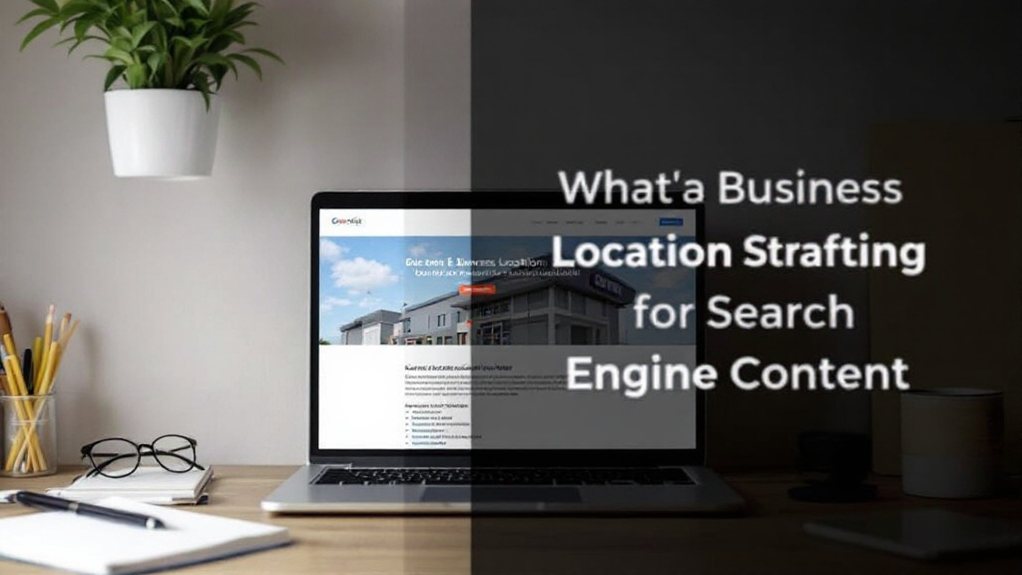To create SEO-friendly business location pages, ensure your NAP (Name, Address, Phone) details are consistent across all platforms. Incorporate localized URLs and location-focused content to boost visibility in city-specific searches. Highlight key business info like hours, services, reviews, and maps to enhance the user experience. Share your company's history and founder's profile to build credibility. Optimize with local keywords and schema markup to improve search rankings. Crafting these elements will not only drive more traffic, but it'll also…
Optimizing NAP Information

Consistent and accurate NAP (Name, Address, Phone number) information is crucial for improving your local SEO. Search engines rely on this data to verify your business locations and rank you accordingly. The approach to optimize a location page depends on the number of business locations. Ensure your NAP details are uniform across all online platforms, including your Google Business Profile and directories. This consistency builds trust with search algorithms and confirms your proximity to searchers, a key ranking factor. Additionally, provide complete address details, business hours, and contact information on your location pages. Enhance user experience by making this information easily accessible and integrating relevant keywords, structured markup, and unique content. Regular updates maintain the accuracy of your NAP, further strengthening your local SEO strategy.
Leveraging Localized URLs

Alongside maintaining accurate NAP information, leveraging localized URLs can further bolster your local SEO efforts. Incorporate your city or location name into your URLs, e.g., "/locations/boston", to improve local discoverability and click-through rates. This approach helps search engines identify your pages' local relevance, boosting visibility in city-specific searches. It also facilitates efficient crawling and better page understanding for both users and search engines. Maintain a simple, readable URL structure, and ensure consistency across all location pages. Combine localized URLs with relevant, location-focused content and schema markup to further enhance your site's local authority and mobile search optimization. [Localized URLs reinforce the geographic focus of each page, making them more likely to appear in location-based queries.
Highlighting Essential Business Details

Aside from maintaining accurate NAP (Name, Address, Phone) information, you'll also want to highlight essential business details on your location pages. Include your hours of operation to manage customer expectations. Provide detailed service descriptions and unique selling points to showcase your offerings. Embed a Google Map and add high-quality photos to enhance user experience. Leverage customer reviews, local endorsements, and case studies to build trust. Optimize your content with location-specific keywords and ensure mobile responsiveness. Regular updates to your location pages will keep information fresh and boost search visibility.
Incorporating Founder and Business History
While maintaining accurate NAP information is crucial, incorporating your business's history and founder details can also significantly enhance your location pages for SEO. Start by including your founding year and key milestones to add depth to your story. A brief profile of your founder can further boost credibility. Highlight your early achievements to set a positive tone, and discuss your local impact and business evolution to demonstrate adaptability. Ensuring consistency across online platforms is vital, as it builds trust and reinforces your relevance. Integrating your unique history as content can create compelling selling points and enhance your brand identity within the local community.
Showcasing Business Visuals and Maps
Visuals and maps are powerful tools for showcasing your business location. Include high-quality photos of your business's exterior and interior to build credibility. Tailor visuals to match your business type, and showcase employees interacting with customers. Use authentic, up-to-date images that reflect your current operations. Optimize images for SEO to increase visibility.
Interactive Maps help users navigate to your location. Address and Directions provide clear guidance to your business. Nearby Attractions enhance user experience and local SEO. Visual Storytelling engages users with your business narrative. Virtual Tours give users a comprehensive view of your space.
Incorporate these visual elements to create an immersive and informative experience for your customers. [Highlighting your unique business offerings through visuals can enhance customer connection and trust.
Conducting Keyword Research and Schema Implementation
Identifying relevant keywords for your location pages is crucial for driving targeted search engine traffic. Knowing relevant local keywords is essential from a UX perspective. Implement schema markup to provide search engines with structured data about your business, enhancing its visibility in local search results. By combining strategic keyword research and schema implementation, you can ensure your location pages are optimized for maximum online discoverability.
Identify Relevant Keywords
Conducting effective keyword research is crucial for optimizing your business location pages for local search. Start by identifying your core topics and brainstorming seed keywords related to your services. Be sure to incorporate location-based keywords, such as your city or town, to target specific geographical areas. Analyze your competitors' online content to gain insights into their SEO strategies, and monitor search trends to refine your efforts over time.
- Use a combination of your main service and location, such as "bakery in Miami."
- Specify your services or products, like "best custom birthday cakes in Miami."
- Incorporate question-based keywords, e.g., "What bakeries in Miami deliver pastries?"
- Explore long-tail keywords with additional details, such as "gluten-free bakery near South Beach Miami."
Implement Local Schema Markup
With your core topics and location-based keywords identified, it's time to implement local schema markup on your business location pages. This structured data boosts your visibility in search results, enhancing click-through rates and customer trust. Utilize schema types like LocalBusiness, Organization, and Review to accurately define your services. Be sure to include key details such as your business name, address, hours, and website. Incorporating local business schema markup can elevate a site's visibility as well as engagement levels shown within search engine results. Regularly validate your schema implementation and update it as your business evolves to maintain SEO performance. By optimizing your location pages with schema markup, you'll improve your local search presence and guide potential customers more effectively.
Ensuring Mobile-Friendly Design
As a business owner, ensuring your location pages are mobile-friendly is crucial for delivering a seamless user experience and boosting your search engine optimization (SEO) efforts. Focus on quick access to information, simple navigation, and easily accessible calls-to-action. Ensure each location page has keyword-rich content for search purposes to attract local customers. Optimize your pages to load within 3 seconds and maintain responsive design across devices. Balance concise content with high-quality visuals, ensuring critical business details remain visible. Incorporate mobile-friendly features like clickable contact info and Google Maps integration. Prioritize SEO for mobile by leveraging local keywords, schema markup, and consistent branding across all device types.
Maximizing Google My Business Listings
Claiming and verifying your Google My Business (GMB) listing is the first step in optimizing your online presence. Manage user access on individual listings or through Location Groups to control who can make changes. Ensure your business information is accurate and up-to-date, and leverage GMB features like posts, Q&A, and reviews to engage with customers. Mastering your GMB listing can significantly boost your visibility and credibility in local search results.
Claim and Optimize GMB
Claiming your Google My Business (GMB) listing is a crucial step in maximizing your online visibility. This process ensures you can manage your business information and maintain accuracy across the web. By claiming your listing, you'll enjoy increased visibility in search results and maps, leading to enhanced customer engagement.
To optimize your GMB listing:
- Maintain consistent business name, address, and phone number (NAP) across all online profiles.
- Choose the most relevant primary and secondary categories to improve search rankings.
- Encourage customers to leave reviews and respond to them regularly.
- Ensure your website, social media, and other platforms display accurate, up-to-date business details.
Utilize GMB Features
Maximizing your Google My Business (GMB) listing goes beyond just claiming it. Reviews are essential for local SEO, so encourage customers to provide feedback. Set up service areas and use offers and events to attract more customers. GMB insights can help you track performance and identify areas for improvement. Keep your business hours and other information updated to ensure consistency across listings.
Use Google Posts to engage customers with news, promotions, or events. The Question & Answer feature builds trust by addressing inquiries. Respond promptly to customer reviews and questions, and set up direct messaging for quick communication. Managing multiple listings? Assign administrators, maintain consistent information, and merge or delete duplicate listings.
Building Relevant Backlinks
Building a strong network of relevant backlinks is crucial for enhancing the local SEO of your business location pages. Leverage major local directories like Google Business Profile and Yelp to create citations that boost your local visibility. Explore niche directories relevant to your industry or location to attract high-quality backlinks. Collaborate with other local businesses to generate mutually beneficial partnerships and joint marketing initiatives. Sponsor community events to acquire backlinks from event websites and increase your brand's local presence. Create hyperlocal content to position your business as a trusted authority and attract relevant backlinks.
Crafting Unique and Engaging Location-Based Content
Crafting unique and engaging location-based content is the next step in optimizing your business location pages for search engine visibility. Use geo-targeted keywords to enhance your search appearance and include location-specific services unique to each business location. Discuss local events and attractions to create a sense of community, and mention testimonials from local clients to build trust. Highlight individual location amenities not available elsewhere, and ensure your content is mobile-friendly for better accessibility. Leverage internal linking and strong CTAs to guide visitors toward conversion. By tailoring your content to match local preferences and behaviors, you can create a personalized user experience that drives engagement and conversions.
